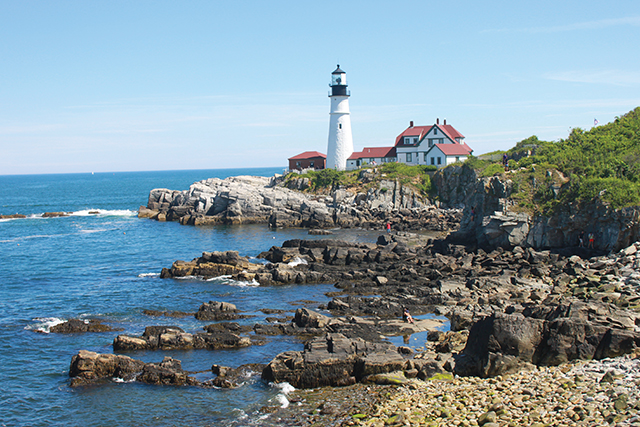Maine’s slogan is right: this is truly the way life should be (published June 2012)
Ah! What pleasant visions haunt me
As I gaze upon the sea!
All the old romantic legends,
All my dreams, come back to me.
Henry Wadsworth Longfellow, who penned these words in “The Secret of the Sea” 150 years ago, was not the first to be inspired by the sea, although he was certainly one of the most eloquent. Guided by the verses of this Portland, Maine native, we set off on a wonderfully varied shakedown cruise along the coast of his home state. Facing more than 3000 miles of coastline, we couldn’t fit everything into 10 days, but we certainly managed to sample some superlatives and find out why Maine deserves its reputation as a sailor’s Mecca.
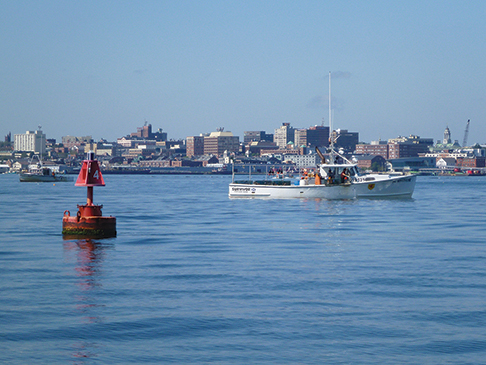
The outfall of Hurricane Irene delayed our departure from Portland, giving us several days to explore the city’s brick streets and green hillsides before our departure. From the narrow shops of the Old Port to the 1807-built Portland Observatory, where signal flags once announced the arrivals of ships to eagerly waiting merchants, we found plenty to keep us busy while we waited. A new side of the city opened itself to us when we followed the Portland Freedom Trail, commemorating the African-American heritage so easily overlooked in America’s whitest state. This gave us a lot to literally look back on when we finally rode the prevailing southwest wind out of Portland harbor, tacking past stone forts and gaining a new angle with every pass underneath the watchful eye of Portland Head Light, commissioned by George Washington himself.
An excellent network of lighthouses and buoys makes route planning in Maine something of a connect-the-dots exercise, but navigation is complicated by tides, currents and hidden ledges—perfect for those who enjoy active sailing in a true cruising ground. In open water at last, we eased the sheets and headed northeast across Casco Bay. O summer day beside the joyous sea! Longfellow wrote, and we were equally exuberant on this early September day.
After a sunny afternoon on the water, we headed up the New Meadows River for The Basin, a local hurricane hole. There, a narrow, river-like entrance turns a corner and opens into a broad oasis with a good mud bottom and room for dozens of boats, though only a handful were there. Anchoring our 35-foot sloop, Namani, at one end of the placid expanse, we all went for a dip. My husband, Markus, and seven-year-old son, Nicky, agreed that the water felt warm for Maine—but still frigid by any other standard! Refreshed, well fed and satisfied with the first day of our cruise, we watched the sunset and turned to Longfellow for a fitting verse: Into the darkness and the hush of night / Slowly the landscape sinks and fades away / And with it fade the phantoms of the day.
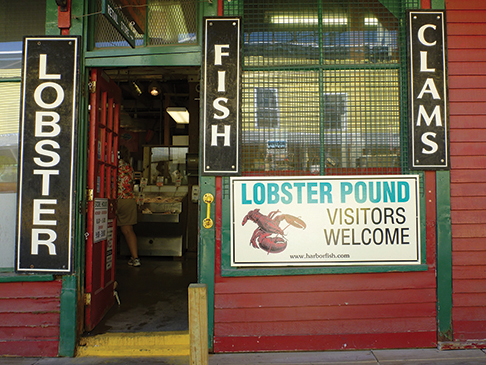 Thanks to our end-of-season timing, one typical Maine phenomenon we did not have to contend with was fog, meaning we could set off early each morning. However, we missed our chance to land on nearby Malaga Island: the low tide (in southern Maine, that’s an 11-foot drop) exposed a ring of rocks, leaving no place to land. Malaga has recently received considerable attention as its little-known history has been brought to light. Mixed-race families who had settled there over several generations were forcibly evicted in 1912 by would-be developers. Some of the residents were even committed to an institution for the “feeble-minded” and the cemetery was exhumed, eradicating any trace of those who had once worked hard to earn an honest living on this tiny, wooded island. The development was never realized and today, uninhabited Malaga is protected by the Maine Coast Heritage Trust (see sidebar). We left Malaga saddened by its unjust history and with regret for our foiled visit. Longfellow’s words were again right on the mark: The tide rises, the tide falls … / The day returns, but nevermore / returns the traveler to the shore / and the tide rises, the tide falls.
Thanks to our end-of-season timing, one typical Maine phenomenon we did not have to contend with was fog, meaning we could set off early each morning. However, we missed our chance to land on nearby Malaga Island: the low tide (in southern Maine, that’s an 11-foot drop) exposed a ring of rocks, leaving no place to land. Malaga has recently received considerable attention as its little-known history has been brought to light. Mixed-race families who had settled there over several generations were forcibly evicted in 1912 by would-be developers. Some of the residents were even committed to an institution for the “feeble-minded” and the cemetery was exhumed, eradicating any trace of those who had once worked hard to earn an honest living on this tiny, wooded island. The development was never realized and today, uninhabited Malaga is protected by the Maine Coast Heritage Trust (see sidebar). We left Malaga saddened by its unjust history and with regret for our foiled visit. Longfellow’s words were again right on the mark: The tide rises, the tide falls … / The day returns, but nevermore / returns the traveler to the shore / and the tide rises, the tide falls.
THE REAL DEAL
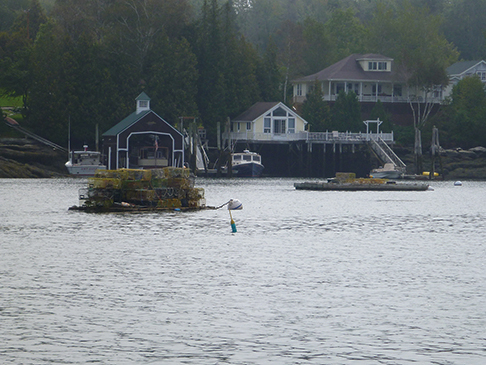
Leaving the lumpy river and Casco Bay behind, we turned the corner of Cape Small for Maine’s Midcoast region, where a series of powerful rivers empty into the sea. These added another element to tide versus wind conditions for a bumpy ride. Calling enough enough, we headed for shelter in nearby Boothbay Harbor. While our mooring there was comfortable enough, the touristy town was a bit of a letdown for those of us who enjoy sleepy towns. Restaurants, cruise operators and knick-knack shops have squeezed fishermen completely off the waterfront, to the point that lobster traps are now stored on floats rather than along the harbor. Now I could understand the ongoing dispute back in Portland, where new zoning regulations threatened to change the character of the working waterfront (a run-down waterfront, yes, but the real thing).
The next morning, we followed prevailing southwesterlies Down East along what Algonquin-speaking natives of the region called the “dawn land.” Crossing the width of island-studded Muscongus Bay, we jumped to our feet at each of four different dolphin sightings—plus one whale sighting. Coming into Penobscot Bay at last, we wondered how different it would be from southern Maine. Together with its little sister, Isle au Haut Bay, Penobscot Bay is 20 miles across at its widest and encompasses a number of islands, from tiny blips of undeveloped islets to chunky blocks that host anything from a handful of crabs to imposing summer residences. There really did seem to be a windjammer around every corner! After the crowded shores of Casco Bay and Boothbay, it was a pleasure to view the green, undeveloped coast, and to observe sights like a young osprey screeching for food from a treetop nest while its harried mother scooped fish straight out of the water in Long Cove. Pleasant it was, when woods were green / And winds were soft and low / To lie amid some sylvan scene.
Penobscot earns its reputation as an outstanding sailing destination thanks to the fact that you can wake up in a quaint New England village like Camden, take advantage of reliable winds for as much or as little sailing as you like, and then tuck into a peaceful anchorage for the night. One popular stopover is Pulpit Harbor on North Haven Island, which is why we found it packed with moorings when we arrived. However, we did succeed in finding enough space to drop the hook after several laps around the harbor. Sunset over the distant Camden Hills brought a fresh arrival: a graceful windjammer negotiated the narrow entrance under full sail, then skillfully rounded up into the wind to drop anchor in the depths of the central bay.
Ah, Maine!
COLD COMFORT
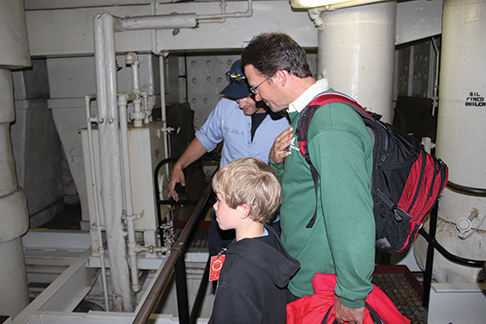
To reach our next stop, Castine, we stooped so low as to motor north on an uncharacteristically windless day. Since it was now after Labor Day, we were able to stay overnight at the town dock with easy step-off access to the historic town. The streets are lined with imposing Federalist houses—so nice that the British didn’t give Castine up until 1815! As a cold front stalled over the area, Longfellow’s poem “The Rainy Day” caught my mood: The day is cold, and dark, and dreary / It rains, and the wind is never weary.
We sought comfort at Bah’s Bakery and the accommodating public library. Castine is home of the Maine Maritime Academy, and during a tour of their training ship, the State of Maine, we were amused to find that just about everything on the 500-foot ship exists in some form on our own boat, albeit in miniature: from radar (we gaped at their mega screen monsters) to the paint locker (theirs is an entire room; ours fits under the port bunk).
Now that we had the village experience (and the rain had stopped at last), we were on a mission to find a remote, quiet anchorage all for ourselves (greedy, aren’t we?). With the combined forecast of a southwest swell with a northwest wind, our choice of anchorages was limited. I had hoped to stop along Merchant’s Row, a line of tiny, pink-granite islets, but none offered the protection we sought. Instead, we charted a course for the island of Vinalhaven in central Penobscot Bay. Lobster buoys moved through the water like so many seals nosing their way north while the current sped us south across the sparkling water. Despite our initial anxiety at the rock-ridden, twisting approach to Seal Bay, we found it easy to follow the deep, central channel. Once we had tangoed through all points of the compass to reach the protection of the inner bay, we had our solitary paradise. Taking the dinghy for a spin, we waddled through the mud flats of a nearby island and watched the requisite seal slip past. The evening was sublime, the highlight of our Penobscot cruise.
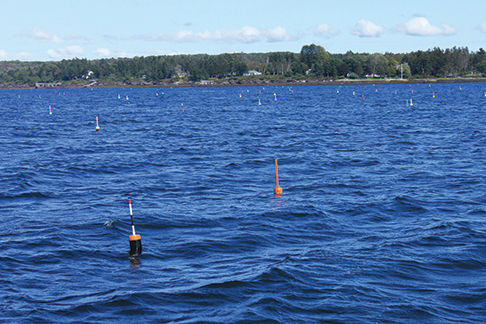
OBSTACLE COURSE
In Maine you can meander Down East, but when you get a rare window of northwesterly winds, you have to grab the chance to backtrack southwest, so a 55-mile day was our next order of business. Namani came on to a beam reach for exhilarating 7 knot sailing, but we now had to contend with the wrath of a sideways Penobscot current. Lobster pots that were normally a nuisance suddenly became a real threat, seeming to torpedo at us from leeward in merciless succession. It struck me that Longfellow wrote poems on everything Maine, including lighthouses (A pillar of fire by night, of cloud by day…) and even seaweed (Ever drifting, drifting, drifting…), but not a word on lobster pots. The crustacean was not yet considered a delicacy in his day—in fact, it was once force-fed to prison inmates, who revolted against such inhumane treatment!
We finished the day with a close reach toward Christmas Cove in Midcoast Maine, just managing to squeak in to the approach without a tack. I could not imagine how Captain John Smith pulled his ship through the needle-sized entrance in 1614, but once inside, he and his crew could certainly enjoy their holiday. (According to a local waitress, the crew also included Pocahontas, but I suspect a little Disney history at work here.) For once, we were glad to pay for a mooring, since the magic of the tiny cove could be shared by a dozen boats instead of just one or two at anchor.
Tacking back toward Casco Bay in a southwest wind, we noticed that the wind was stronger close to land in the late morning—although this observation was a moot point in the afternoon, when a hearty 25-knot wind blasted us along under blue skies. The final obstacle of the day was a dense field of lobster buoys strewn like colorful confetti through narrow, ledge-lined slots between islands. Once safely through the obstacle course, we hooked a mooring at a small cluster of islands called The Goslings. In this lovely spot, the sounds were as striking as the wild sights: at night, we listened to the whistle of the rising wind, and in the calm of the morning, the croaking sound of resident seals.
Only 13 miles from our final destination, we slipped our mooring and headed back to Portland, Longfellow’s beautiful town that is seated by the sea. Namani had covered 250 miles in 10 days (including a three-night stopover), visiting some of Maine’s premier cruising grounds. In addition to fantastic sailing and unforgettable landscapes, we enjoyed the poetry of Longfellow and caught glimpses of local history. Mainers are helpful and
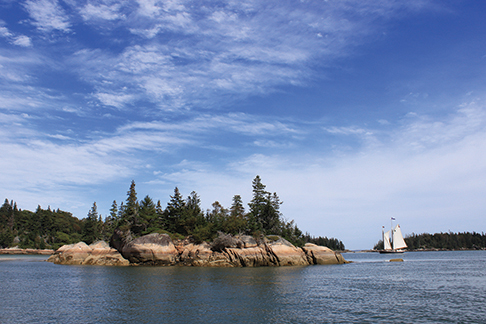
patient with strangers while keeping true to their own quiet mannerisms (and looks—thoughts of creating a poster featuring “The Beards of Maine” kept returning to my mind). Was our thirst for Maine cruising satisfied? Hardly, but our experience does show how much sailors can do given a place so full of possibilities. And there’s always the hope of second visit!
Let us, then, be up and doing / With a heart for any fate / Still achieving, still pursuing / Learn to labor and to wait.
Nadine Slavinski is the author of Lesson Plans Ahoy, an educational resource for sailing families. She lives and cruises aboard her 1981 Dufour 35, Namani, with her husband and young son.
The Maine Coast Heritage Trust
The lovely views that draw cruisers to Maine—endless spruce forests; wild, rocky shorelines—haven’t escaped development by chance. A number of advocacy groups work hard to protect and preserve the pristine landscape. Chief among them is the Maine Coast Heritage Trust (www.mcht.org), or “the 800-pound gorilla among the chipmunks of Maine coastal land trusts,” as one insider puts it. MCHT seeks to protect land without encouraging mass visitation, and at the same time, honoring low-impact, traditional uses. Malaga Island and Seal Bay are among the best-known MCHT preserves; others are intentionally low-profile.
Jane Arbuckle, Director of Stewardship for MCHT, says “it would be wonderful if cruisers were more aware of all the work and resources that go into preserving these places.” Beautiful scenery comes at a price, so cruisers should do their part by supporting the efforts of MCHT, other Maine conservation groups or a group in their home cruising grounds.
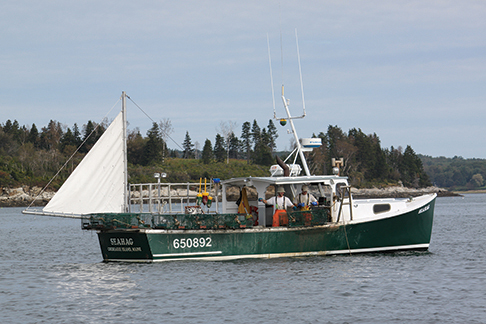
Must-Reads for the Maine-bound Sailor
The bible of Down East cruising is A Cruising Guide to the Maine Coast, by Hank and Jan Taft and Curtis Rindlaub. Aside from detailed piloting information, this book includes fascinating sidebars on history, culture and wildlife. If only all cruising guides were like this one! Another good book is Roger F. Duncan’s Sailing in the Fog, a classic packed with sound advice and interesting stories.
Bill Caldwell’s engaging Islands of Maine is another must-read for the Maine-bound cruiser; chapters blend notes on history and culture with personal anecdotes. Linda Greenlaw’s The Lobster Chronicles will give readers a new appreciation for the lobstermen who always take a moment to wave hello on the water.
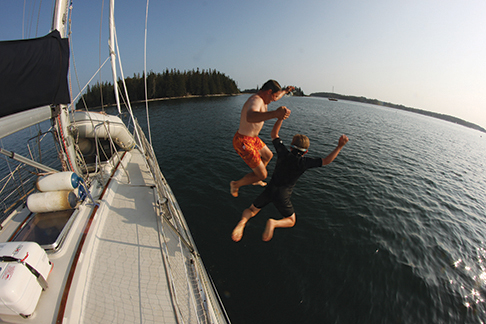
Lizzie Bright and the Buckminster Boy, a historical fiction work by Gary Schmidt, should be on any cruiser’s required reading list. It is a beautifully written tearjerker that puts a human face on the sad history of Malaga Island. Junior crew can dig into Maine classics like Robert McCloskey’s Blueberries for Sal or One Morning in Maine.















